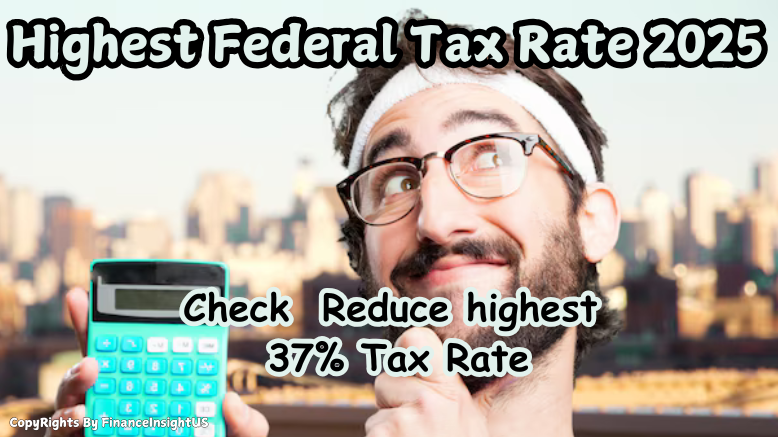There are seven different federal income taxes rates which lie between 10% to 37%. What are your federal income tax brackets? Learn how they operate and how you can reduce your taxes.
Highest Federal Tax Rate 2025
There are seven income tax brackets and rates in 2024 and 2025 which are 10%, 12%, 22%, 24%, 32%, 35%, and 37%. Your filing status and taxable income figure out which tax rate applies to you and how much taxes you owe in that year.
Due to the Tax Cuts and Jobs Act of 2017, the federal tax rate will continue to be the same until the end of 2025. In order to reflect inflation, the IRS modifies the income limits which decides tax rates.
2024 Tax Brackets (taxes due April 2025)
Your 2024 earned income is subject to the 2024 tax brackets and this income will be reported on the 2025 tax return.
| Tax Rate | Single | Married Filing Jointly | Married Filing Separately | Head of Household |
| 10% | $0 to $11,600 | $0 to $23,200 | $0 to $11,600 | $0 to $16,550 |
| 12% | $11,601 to $47,150 | $23,201 to $94,300 | $11,601 to $47,150 | $16,551 to $63,100 |
| 22% | $47,151 to $100,525 | $94,301 to $201,050 | $47,151 to $100,525 | $63,101 to $100,500 |
| 24% | $100,526 to $191,950 | $201,051 to $383,900 | $100,526 to $191,950 | $100,501 to $191,950 |
| 32% | $191,951 to $243,725 | $383,901 to $487,450 | $191,951 to $243,725 | $191,951 to $243,700 |
| 35% | $243,726 to $609,350 | $487,451 to $731,200 | $243,726 to $365,600 | $243,701 to $609,350 |
| 37% | $609,351 or more | $731,201 or more | $365,601 or more | $609,351 or more |
2025 Tax Brackets (taxes due April 2026)
Your 2024 earned income is subject to the 2024 tax brackets and this income will be reported on the 2025 tax return.
| Tax Rate | Single | Married Filing Jointly | Married Filing Separately | Head of Household |
| 10% | $0 to $11,925 | $0 to $23,850 | $0 to $11,925 | $0 to $17,000 |
| 12% | $11,926 to $48,475 | $23,851 to $96,950 | $11,926 to $48,475 | $17,001 to $64,850 |
| 22% | $48,476 to $103,350 | $96,951 to $206,700 | $48,476 to $103,350 | $64,851 to $103,350 |
| 24% | $103,351 to $197,300 | $206,701 to $394,600 | $103,351 to $197,300 | $103,351 to $197,300 |
| 32% | $197,301 to $250,525 | $394,601 to $501,050 | $197,301 to $250,525 | $197,301 to $250,500 |
| 35% | $250,526 to $626,350 | $501,051 to $751,600 | $250,526 to $375,800 | $250,501 to $626,350 |
| 37% | $626,351 or more | $751,601 or more | $375,801 or more | $626,351 or more |
Understanding Tax Brackets and Rates: A Simple Guide
1.Income Tax Brackets:
People with high earnings are required to pay higher tax rates while people with lower incomes are subjected to lower tax rates due to progressive tax system in the United States.
Government evaluates how much you owe by splitting your taxable income into pieces, and it chunk each individual at a separate rate. The range of tax rate is between 10 to 37%.
The benefits of tax brackets is that your entire income is not subject to taxes no matter how many brackets you are in. You just only need to pay on a portion of your income whether it’s high or low.
2.How State Tax Brackets and Rates Impact You?
States and the federal government don’t handle taxes in the same way. Individuals’ specific state and federal government tax brackets can be different, for instance, Colorado has a flat tax rate of 4.4% on taxable income while Wyoming doesn’t require such state income tax.
3.How Inflation Affects Income Tax Bracket Adjustment?
To reflect the current rate of inflation, the range of income where a certain tax rate starts and stops, also known as federal tax brackets, are adjusted annually. These inflation adjustments impact significantly on the tax system.
A phenomenon known as “Bracket Creep” happens when taxpayers are pushed into high taxes without actually raising their incomes and the tax bracket adjustment prevents them from this situation. People whose pay has not kept pace with inflation can also reduce their taxes.
How Marginal Tax Rates Work?
The marginal tax rate is the tax rate applied to the final dollar of taxable income. It often corresponds to your highest tax bracket.
For example, if you’re a single filer in 2024 with $35,000 in taxable income, you’ll pay 10% and 12% in taxes. If your taxable income increased by one dollar, you would pay an additional 12%.
What is an Effective Tax Rate?
The percentage of your taxable income that you pay in taxes is known as the effective tax rate. Divide the total tax owing (line 24) on Form 1040 by the total taxable income (line 15) to calculate your effective tax rate.
Strategies to Lower Your Owed Tax
The common methods which can help you to reduce your owed taxes are deductions and credits.
- Tax credits can decrease your tax payment dollar for dollar, regardless of whatever bracket you are in.
- Tax deductions, on the other hand, diminish the amount of your income that is taxable. Deductions reduce your taxable income by a percentage of your highest federal income tax rate. So, if you are in the 22% tax rate, a $1,000 deduction may save you $220.
In short, you have to claim deductions as much as you can because it pushes you into lower brackets and you are required to pay a low tax rate.



